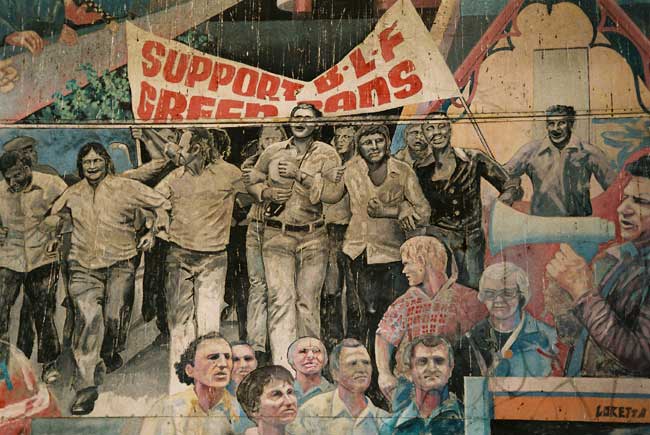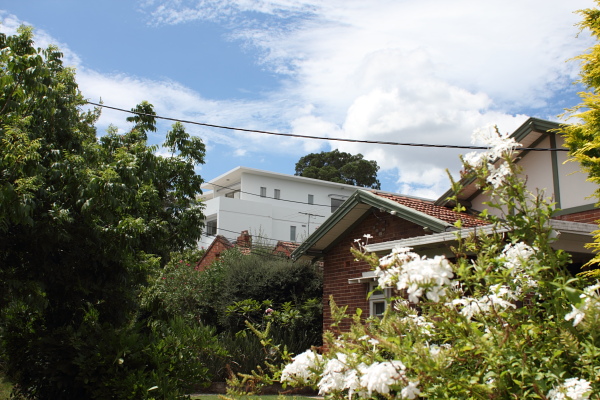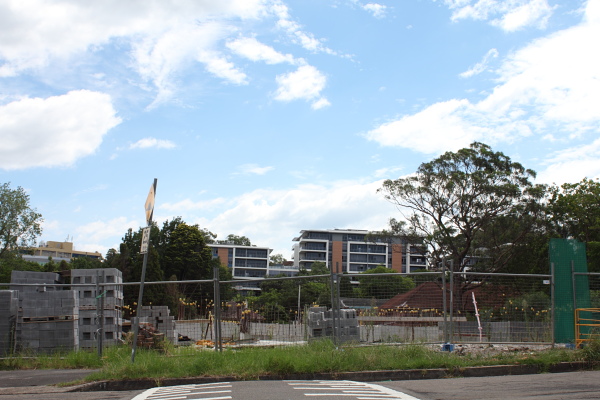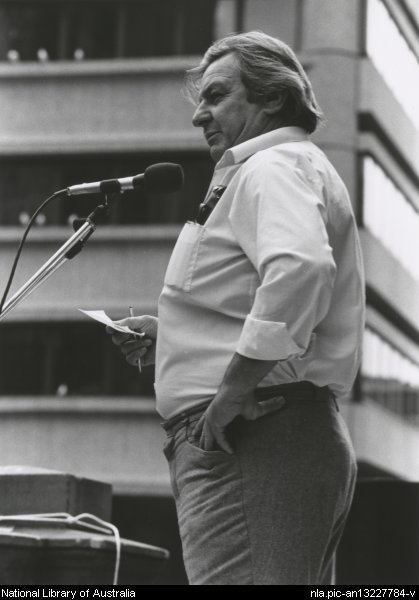This article was originally posted as State of Siege, a New Documentary on Sydney’s Destruction on The Berkshire Review on 20 Mar 2011 and is being republished here with the kind permission of the author. It was originally posted on this site on 15 Mar 2011
.
Andrew Miller reviews State of Siege
a documentary by Dennis Grosvenor previewed (here)
This film was screened at the Roseville cinema on 16 February 2011, 13 March 2011.
Note: This film is to be screened again on at 1:15PM Sunday 20 Mar 2011 at the Roseville Cinema in Sydney.
Editor's comment: It is hoped that there will be many more public screenings and also in locations outside of Sydney, particularly other capital cities like Brisbane, Sydney and Perth, whose future prospects may be little better than that of Sydney, that is, if knowledgeable people with consciences don't act effectively soon against developer greed.

Having spent the afternoon before this one-off screening at the Nicholson Museum of ancient art, in their new re-presentation of their Egyptian collection through the eyes of Herodotus, I came across this quotation:
Cheops brought the country into all sorts of misery. He closed all the temples, then, not content with excluding his subjects from the practice of their religion, compelled them without exception to labour as slaves for his own advantage. Some were forced to drag blocks of stone from the quarries in the Arabian hills to the Nile, where they were ferried across and taken by others, who hauled them to the Libyan hills. The work went on in three-monthly shifts, a hundred thousand men in a shift. It took ten years of this oppressive slave-labour to build the track along which the blocks were hauled — a work, in my opinion, of hardly less magnitude than the pyramid itself.
The Egyptians can hardly bring themselves to mention the names of Cheops and Chephren [his successor], so great is their hatred of them; They call the pyramids after Philitis, a shepherd who at that time fed his flocks in the neighbourhood.1
Will we still despise the New South Wales government in 2000 years? It doesn't seem so very far fetched. At least Cheops had a sort of vision, the pyramids have a certain stark beauty of their own and they draw many wealthy tourists. The eagerness to destroy and thugishness of the current NSW government is extreme and is it really so much worse to steal people's labor than their homes? For that's what we witness in this new documentary. As the environmentalist, bushwalker and businessman Dick Smith points out in his interview, rezoning a person's land is tantamount to stealing it because they will have no choice but to sell to the developer who puts up two ugly apartment blocks on either side of them. After food and water (and nowadays we are forced to add) clean air, shelter is the most basic human need. Interfering with people's homes thus pokes even deeper into the human psyche than the layer where Freud put his conception of the libido. The lower levels of government (state, province, local) affect our lives directly in a way the feds cannot. The wonder is that many in NSW aren't angrier.
The movie starkly exposes the developers' and the NSW government's destructiveness. It begins with images from Dennis Grosvenor's neighborhood in Roseville, a mostly leafy suburb in Sydney's North Shore, about 12 km (7 miles) from the downtown. We see harrowing shots of beautiful, old, well designed (as is usually the case in houses built before the age of private air conditioning), sturdily-built double brick houses crushed by bulldozers (with not even the slightest attempt to recover, reuse or recycle any of the timber, glass or bricks), fertile gardens compacted under caterpillar treads, and enormous old trees chain-sawed. There are also beautiful images of the local flora and fauna: tree ferns dappling the sunlight, tall trees native and exotic, wild parrots and lorikeets, native turkeys and a ringtail possum, species who had been been able to share this environment with people for the better part of 100 millennia, and even managed to adapt to a semi-urban environment of the last century. Mr Grosvenor had found this scene of destruction next door on returning from vacation, making way for a block of "luxury apartments," that absurd throwback from Gordon Gecko's Manhattan of the 1980's, which certain greedy developers are throwing up all over Sydney, to the outer suburbs and beyond. All have a self-similar appearance beyond ugliness, which rather seems designed to jar the senses of anyone least bit sensitive, and demoralize those sensitive to nature. Mr Grosvenor had had no warning or notification from the local or NSW government, let alone an opportunity to comment or object.


How is this possible? There does exist a local government council which has managed for around a century, more or less competently, the transition of the area (known as Ku Ring Gai) from a few vacation cottages near wild bushland at the edge of the city to a garden suburb populated year round. In just the last few years, the area has been transformed into another hot, leafless, concrete Sydney suburb, albeit with disjointed pockets of the old left over. The NSW government amended the planning law in 2005 with the infamous "Part 3A", which allows developers, if their project is big enough, to go over the heads of local government and apply to the NSW Department of Planning to get a rubber stamp. Bureaucrats assess whether the development is good for the neighborhood and the minister, whose constituency is more likely than not nowhere near the neighborhood in question, ticks off on it, and none of them need ever see, let alone live with the result. The number of rejected applications could be counted on one hand. Meanwhile the NSW government pressures local councils over smaller apartment blocks, at least providing them with a demon to pass the buck to. And so in just a few years Ku Ring Gai has been trashed and denuded. As the film points out the NSW government put this system in place after some $200,000 a year in political donations from developers to their Labor Party, much more than any other special interest or industry in the state, except perhaps the mining industry.
Mr Grosvenor quickly but clearly explores the history of modern Sydney planning. The micro- and macrocosm generally share in his film very fairly. In the late 1960's to the 1970's then NSW premier Bob Askin (parliamentary equivalent to the governor) decided to redevelop the Rocks and Woolloomoolloo (accent on the first and last syllable), two neighborhoods adjacent to the downtown which housed blue-collar workers and longshoremen for many years and the Rocks is the closest thing Sydney has to an historical quarter. The plan was to kick out the workers, bulldoze their houses and build some especially mediocre modernist office buildings (but arguably better than the current Barangaroo plan). In both cases, Jack Mundey leader of the Builders' Labourers' Federation (BLF), the union representing all workers involved in demolition and construction, stopped the plan by imposing a "green ban," a general refusal to demolish the old buildings or lay footings for new ones. The decision for the green ban followed close talks between the local residents' groups and Jack Mundey. Neither the developers nor the government could do anything to bypass the green ban, and the union and residents held firm despite threats, thugs breaking down residents' doors and coming in in the middle of the night, and the murder of local journalist Juanita Nielsen.

The BLF stopped some $4 billion worth of construction in the early 1970's2. Sydney has not missed this "lost investment," as bankers and developers would cry today, in fact the Rocks has become a veritable tourist trap and Askin is remembered as one of the most corrupt politicians in our history. Mr Grosvenor interviews Mr Mundey as well as John Hatton, who was an independent NSW MP from 1973 to 1995 and initiated the Wood Royal Commission into police corruption, which exposed government links to organized crime. Mr Mundey is refreshing to hear and provides relief from depressing times. He speaks plainly and to the point and comes across as artless and very thoughtful, an independent and critical thinker, whose natural modesty only allows his passion for the truth and the morally right to shine out more clearly. It is John Hatton, I believe, who says on film that the current government is the most corrupt since Askin and that a Royal Commission into them would be more important than the Wood Royal Commission. The film provides a fresh breath air over the depressing corruption we have lived with day to day for a decade, and the straight talk of the interviews allowed me to forget about the dreary daily cant from the government and newspapers for a moment.
The film points out that the developers and government are less crude than they were 40 years ago and that corruption has become a smooth system. There is footage of the current Premier Kristina Keneally explaining how her government is not corrupt because they haven't broken any laws. But they pass the laws, often with dirty dealing with right-wing minor parties, and as Greens MP Lee Rhiannon points out in her interview, history teaches us that there is such a thing as a wrong law, as I'm sure the Egyptians and Herodotus could confirm. The NSW planning laws include lip service to "community consultation," reducing the fundamental democratic right to weasel words. They build loop holes into their laws, for example their 2009 "affordable housing" law, not mentioned in the film, which sounds very progressive, but should not be confused with public housing. This law defines "affordable" housing as a 20% rent discount on half the apartments of a development to people earning up to about $90,000 p.a. and the developer gets a taxpayer handout of around $9,000 per dwelling per year (partly from the federal government) and can by-pass local zoning rules, putting extra apartments on the site for the privilege. Property development in Sydney requires no mind, let alone government assistance, only a pile of money or property to start with, then it is self propagating, since every neighborhood is in demand, large profits are inevitable. Even so, the film shows Keneally promising to introduce new laws to allow compulsory acquisition of people's houses for private developers.
They have also invented a whole new set of logical fallacies to lubricate this system. So many of the citizen activists interviewed in the film from the remote Catherine Hill Bay (where the government imposed an order of magnitude increase in the the size of the village) to Asquith on Sydney's northern edge and Mr Grosvenor himself in Ku Ring Gai, repeat the refrain "we made every rational and reasonable argument but the government didn't listen." People are put in the cruel situation where even if they swallow the emotional upset of losing their house and habitat to make logical arguments against blatantly ugly, destructive and plain old-fashioned wrong developments next door, but the government ignores them anyway, perhaps paying platitudes or responding with propaganda whose clunkiness makes the USSR's sound sophisticated. Even more cruel is this favorite response to the concerned citizen I have heard over and over again: "Well you're not an expert. Rest assured we have many expert public servants in all fields working for us in the department." A most ignorant, egregious, easy and undemocratic dismissal — besides being fundamentally against free speech, it essentially depends on the absurd concept of an "expert professional planner" who always trumps the experience and sense of even the oldest local resident. Why don't we just hire experts to vote for us too? This particular furfy has been getting more and more dangerous as it becomes more and more common lately, to the point where the other day I heard it used in a newspaper letter to the editor to justify self-censorship.
The government denies freedom of the press as well. The film shows us a frightening scene of a NSW government-appointed panel of "planning experts" throwing a video journalist out of a public meeting for trying to record the proceedings, just before they approve further rezoning of Ku Ring Gai. We only have a video record thanks to some heroic citizen in the back of the auditorium who caught it all on a small camera (see another view here). Then there are the muzzling anti-defamation laws, which quiet people through fear of the threat of litigation and occasionally through actual litigation of high profile examples. Without a Bill of Rights in the Australian Constitution, a legal last resort in the High Court is not assured. Traditionally, Australians are supposed give one-another the benefit of the doubt and look out for one another's human rights since no individual would want to lose them, while maintaining vigilance at the same time. Powerful people, governments and corporations have taken advantage in the past and do so more and more frequently as power flows away from the individual faster and faster.
So why are these people still governing the state? They would have lost the election four years ago if the opposition hadn't been bigoted and hadn't promised to bulldoze an inner Sydney aboriginal neighborhood. The next election is on 26 March and the polls show the Labor government will lose by the largest margin ever recorded in a poll. This time the opposition Liberal Party under Barry O'Farrell, whose constituency happens to be Ku Ring Gai, has promised to repeal Labor's planning laws and rewrite from scratch. But his party also took a lot of money from developers over the years, even if they have since stopped. Dick Smith proposes publicly funded elections, but will this solve the problem? The amount donated is chicken feed compared to the profit from even one "small" development. So what really motivates these politicians, and their minion appointees and public servants, to corrupt themselves? What do they get out of destroying Sydney? For that is what's happening — Sydney has nothing if not its natural beauty: the harbor, the beaches, the marsupials, parrots and kookaburras, tall trees and sandstone formations in the bush — as any tourist knows and appreciates. A hint to the answer to this question may lie in the film's description of former Labor politicians like Graham Richardson who quit politics to find himself in a lucrative job lobbying the government for various interests including the property developers' and consulting for them. There is no law to stop a public servant from working for the government for some years, learning the system in detail with a mind to quit and take a private sector job polishing development applications with their "expertise." Former Labor Premier Bob Carr now works for the ultra-rich investment bank, Macquarie Bank, who among many other useful bits of Sydney, bought most of the airport. I know of no investigative journalist who has found out exactly how a NSW politician benefits from supporting developers and maintaining the housing bubble. The Sydney Morning Herald seems content to uncover just enough to raise its readers' eyebrows, sometimes even their ire, with sporadic and disconnected investigations, but always stops short of j'accuse, or a real piece of investigative journalism exposing criminal conduct. There seem to be no plans by the opposition to set up a Royal Commission into the current government's developer connections, despite Mr Hatton's calls.
Like any good documentary, this one raises as many questions as it answers. Why did the green ban go extinct, why aren't they saving Ku Ring Gai or preventing the loss of Barangaroo, or the destruction of Sydney and other parts of NSW in general? I suspect it has something to do with the fact the BLF was permanently dissolved in the 1980's and replaced by the amalgamated Construction, Forestry, Mining & Energy Union. How could that behemoth possibly be pro-conservation? Union workers, and other sectors' workers for that matter (especially suburban apartment-dwellers), now seem content as long there are jobs available and wages are just enough to afford property to live on and so get a piece of the action, however tiny. Meanwhile I see construction workers throwing up apartments in Ku Ring Gai, working over the weekend (so much for the 35 hour week so hard won) and convoys of 22 wheelers noisily hauling away tonnes of fertile garden soil so carefully cultivated for maybe 100 years, and which could have at least provided many people's vegetables, but happened to be in the way of a new apartment block's 2-car-space-per-apartment parking garage, and adding to the poison miasma hanging over the Pacific Highway, Sydney's main north-south thoroughfare, already choking on mindless car culture, and the only thing which can still give me an asthma attack.


A difference I noticed from the film's footage of the BLF's and residents' groups' demonstrations in the 1970's compared to demonstrations today is certain loss of spirit and attitude. These days demonstrations consist more of amusing self-deprecating speeches by celebrities and people blowing off steam — which is of course a valid and vital purpose to a demonstration as it is reassuring to meet with like-minded people — but the images of Jack Mundey with his megaphone, his voice fraught with heightened emotion and passion yet able to make the most reasonable arguments show something has been lost. No one glibly dismissed him and his "unskilled" union as not being "experts." There was a passion and forcefulness which has been suppressed either through self-censorship or their fear of giving up the addiction to capitalism in boom times, though some of that old spirit did energize State of Siege.
Perhaps some citizens of NSW are developing Stockholm Syndrome under our besiegers. The politicians of today are able to manipulate our emotions by giving us vents to blow our steam through — letters to ministers or our member of parliament, written submissions to the government (I'm not sure whether they intended the double entendre) arguing against development applications, demonstrations and marches despite the utter lack of individual power beyond their vote. I fear that the New South Welshpeople will blow off much steam at the ballot box next month and assume change will result, but the special interests will still be powerful and the at-best disappointing public servants will remain in their offices. As the film concludes, the problem is capitalism and its philosophy of growth as the meaning of life, which benefits only those few who happen to already have a pile of money. They consume nature at an exponential rate and nothing is allowed which doesn't pay for itself in the following financial year, but it's okay if its self-financing's resource-binge defrauds our future. With the institutionalized greed, the emotional manipulation, the impinged free speech and free press I wonder if the NSW government really treats its citizens any better than King George treated the American colonists before they revolted. This government, like so many despised leaders in the past, seeks immortality in a monument to capitalism on Barangaroo, a plan much more popular than it should be; the design is objectively uglier than the pyramids and we all saw what happened in Egypt.
This movie deserves more than one screening. It should be shown all over the state if not further afield. It looks very professional and it is surprising it is Mr Grosvenor's first documentary; he manages avoid a depressing tone — indeed at times he sounds Zolaesque — without resorting to a contrived and hollow throwaway hope at the end, as some higher budget activism-documentaries do. There are a few problems with the sound: I suspect some of the interviewees' voices were subject to loudness filters, making the soundtrack shrill while the voices boom like a radio news reader's, which made some words hard to make out. Also the music isn't good, why not use public domain classical music? Dies Irae or the funeral march from Beethoven's 3rd would be perfect. It is not a slick-looking film and has an honesty as Mr Grosvenor puts content and information to the fore. I think this movie would be appreciated overseas too, where property developers' reputations aren't much better and the images of wild parrots, at least, always fascinate.
—
1 Herodotus, The Histories. Translated by Aubrey de Sélincourt, Penguin Books 1954-2003.
2 Kate Blackmore, A Good Idea at the Time: The Redevelopment of the Rocks, from Peter Webber, ed., The Design of Sydney. The Law Book Company Ltd. 1988.
A demonstration against the plans for Barangaroo is being organized for Tuesday 15 March 2011 at 12:30pm at 30 Hickson Road Millers Point. I hope there are lot's of people.Editor's comment: This review is being posted on Tuesday 15 March, unfortunately too late, even for interested readers to participate in the demonstration. A report of the demonstration in today's Sydney Morning Herald by Matthew Moore is Uproar as law is altered to favour Barangaroo hotel.
See also:

Comments
Milly O (not verified)
Wed, 2011-03-16 17:44
Permalink
Plague of humans and the coming decline
Anonymous (not verified)
Wed, 2011-03-16 20:34
Permalink
Economic growth - the big consumer
Suzanne (not verified)
Mon, 2011-04-04 15:05
Permalink
"Under Siege"-like destruction happening every week in Melbourne
Sheila Newman
Wed, 2011-04-06 02:58
Permalink
People want to stop development juggernaut but don't know how
gait (not verified)
Thu, 2013-12-26 14:39
Permalink
Praise from web publisher
Highly energetic post, I liked that a lot. Will there be a part 2?
Visit my web-site madeinslovenia.net,
gait
Add comment